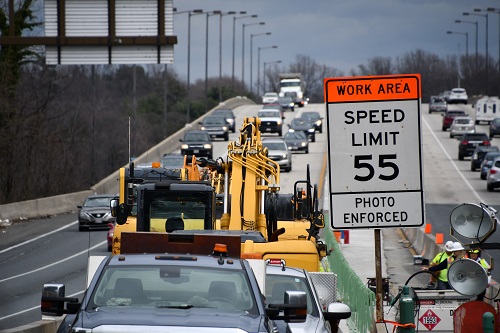
Why we have speed limits
A speed limit indicates the maximum speed that is deemed safe for favorable roadway and traffic conditions. Providing an appropriate speed limit helps road users to react safely to encountered problems on roadways, and results in a reduction of crashes. Also, proper speed limits tend to reduce differences in speeds of road users, which provides smoother traffic flow on roadways, and it helps to increase efficient use of the roadways with balancing risk and travel time. Lastly, it is essential for law enforcement to provide sanctions for the reckless, irresponsible, and negligent road users.
How speed limits are set
Speed limits for various streets and highways are set by Maryland vehicle law. In many instances, these statutory limits do not account for road contexts and actual traffic conditions important in the safe and efficient movement of traffic. The law allows these limits to be adjusted based on traffic engineering studies.
What are statutory speed limits?
Maryland Code, Transportation § 21-801.1 establishes the maximum speed limits on most typical roadways as the following:
- 15 miles per hour (mph) in Alleys in Baltimore County
- 30 mph on all highways in a business district and undivided highways in a residential district
- 35 mph on divided highways in a residential district
- 50 mph on other undivided highways
- 55 mph on other divided highways
- 70 mph on interstate highways and expressways
What conditions influence speed limits?
Speed limits are set higher or lower than the statutory limits when one or more of the following circumstances are present:
- Significant pedestrian or bicyclist traffic and schools
- Unusual traffic characteristics because of land use or other conditions
- Frequent crashes in which speed is a contributing factor
- Transition between rural and urban areas on major highways
- Road design elements that are substantially differ from the norm
- Road construction
After a speed limit is established, changes could prompt a new traffic engineering study to determine if the speed limit needs to be raised or lowered.
What is a traffic engineering study?
A traffic engineering study is the observation and analysis of road and traffic characteristics to guide the further application of traffic engineering principles. The study of speed limits examines various different factors such as the following:
- Road context (such as roadside development and environment including the number of driveways, land use, functional classification, parking practices, and presence of sidewalks/bicycle facilities)
- Road users including pedestrians and bicyclists
- Road characteristics (such as lane widths, curb/shoulder condition, grade, alignment, median type, and sight distance)
- Reported crash experience or rate for at least a 12-month period relative to similar roadways
- Observed and measured vehicle speeds at one or more representative spots along the road in ideal weather and under free-flowing traffic
Frequently Asked Questions
If motorists speed through a residential neighborhood, what should be done?
If the speed limit appears to be appropriate but speeders are creating a hazard, that calls for enforcement. Contact the law enforcement officers with jurisdiction over your street and ask them to check speeds and enforce the law.
If your street's speed limit itself seems unrealistically high, contact the traffic engineering agency with jurisdiction – all large political subdivisions have a traffic engineering office. If there is no such office, contact your law enforcement agency.
What if those steps fail to achieve appropriate speeds?
Some residential areas need slower speeds than posted speed limits. Traffic engineering studies can determine if "traffic calming" techniques, such as roundabouts, chokers, raised crosswalks, pedestrian refuge areas, or other physical controls, can reduce speeds and make your street safer.
Is it always safe to drive at the speed limit?
Speed limits are set for ideal conditions. Drivers need to respond to adverse conditions. Maryland vehicle law requires that motorists drive at a reasonable and prudent speed and with a regard for danger. Motorists must adjust their speed according to the following: 1) existing vehicle, pedestrian, and bicycle traffic and 2) road surface, lighting, and weather conditions. You should always maintain a safe speed.
Contact Information
Maryland Department of Transportation State Highway Administration
Office of Traffic and Safety Traffic
Development and Support Division
7491 Connelley Drive
Hanover, MD 21076
410-787-5860